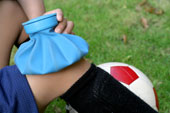
 Along with blisters and sprains, muscle strains are among??the most common afflictions for active persons in the outdoors. Common medical??dogma is to use the a??RICEa?? ??approach for??sprains and strains ofa??rest, ice (application of cold), compression, and??elevation.
Along with blisters and sprains, muscle strains are among??the most common afflictions for active persons in the outdoors. Common medical??dogma is to use the a??RICEa?? ??approach for??sprains and strains ofa??rest, ice (application of cold), compression, and??elevation.
This is more applicable to sprains (e.g., an ankle sprain) than to??strains, because the sprained body part is usually a limb (ankle, knee, wrist)
that is amenable to this approach. Strains more often involve larger muscle
groups, such as those in the back, chest, thigh or abdomen, or??difficult-to-approach areas, such as the neck or groin.
Prevailing theory for treatment of a muscle strain is that??one applies external cold for 24 to 48 hours, and discontinues it after 72??hours, at which time one begins application of external heat. The rationale is
that swelling (from leakage of blood and tissue fluid) and inflammation prevail??in the first two days, and that after three days, one wishes to increase local??circulation and augment reabsorption of the fluid that has collected. There is??some science to this, and these recommendations have been around for as long as??I can recall.
I just read a paper entitled a??Heat or Cold Packs for Neck??and Back Strain: A Randomized Trial of Efficacy,a?? authored by Gregory Garra and??his colleagues (Academic Emergency??Medicine 2010;17:484-489). The purpose of the study was to compare the??pain-relieving benefit of heat versus cold in the treatment of back and neck??strains. The authors started out with the scientific hypothesis that there??would be no difference between the two temperature modalities. Patients??included in the study were 18 years of age or older. All of the patients??received 400 milligrams of ibuprofen orally and then were assigned in a random??fashion to receive 30 minutes of either a heating pad or a cold pack applied to??the injured body region. A variety of methods were used to assess pain before??and after therapy.
There were 31 patients in the heat-treated group and 29??patients in the cold-treated group. In the final analysis, there was no??difference between the groups either in their demographics or in response to??the therapies. The authors admitted that pain relief may have been due to the??painkiller anti-inflammatory drug ibuprofen, and not to the heat or cold??therapies. However, if there was an additional beneficial effect from the heat??or cold, no difference between the two was noted.
So, what can we conclude from this study? Really, not much.??The confounding factor of administration of ibuprofen interferes with any??direct conclusion about the heat and cold, other than that in combination with
ibuprofen, neither appears to offer an advantage over the other.?? Indeed, there wasna??t even a control group,
which in this case would have been ibuprofen administration alone without??adding heat or cold. What if ibuprofen alone generated the same amount of??improvement? Furthermore, how about a longer duration of heat/cold therapy???Might that have yielded more or less improvement? What about time to complete
resolution of symptoms? It would have been interesting to follow these patients??until their pain was completely resolved, to determine if despite the rapid??effects upon pain relief, there were any implications to time to total resolution??of symptoms (and presumably, healing).
Based on this particular study, I really cannot draw any??conclusions, so will stick with the dogma until someone reports something to??make me change the traditional approach. My advice to the readers is to stick??with cold first for acute muscle strains, then transition to heat after 72??hours.
This post, Muscle Strain: Should You Treat It With Hot Packs Or Cold Packs?, was originally published on
Healthine.com by Paul Auerbach, M.D..
No comments:
Post a Comment